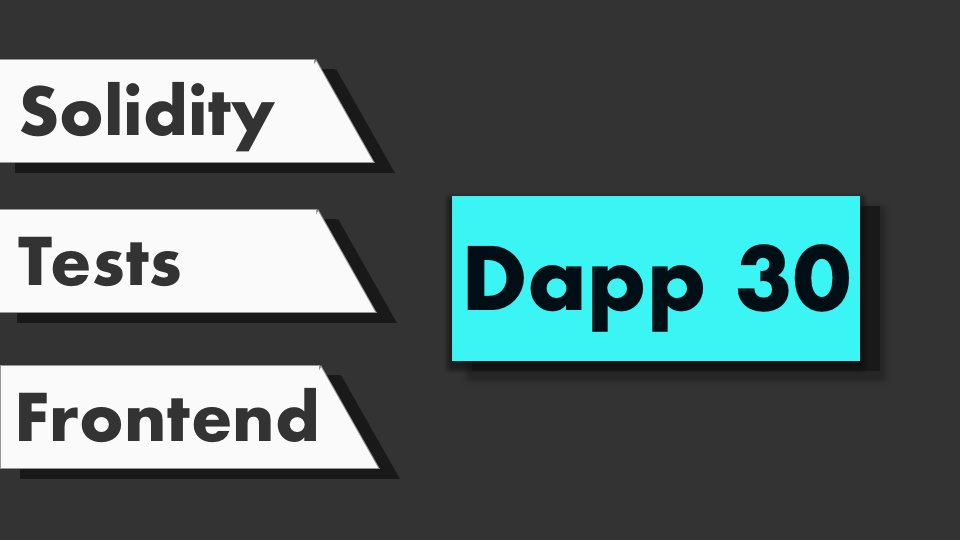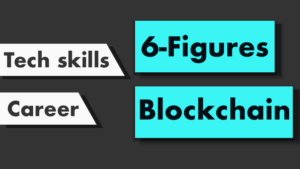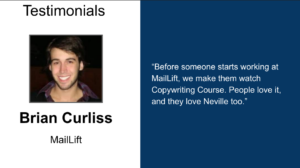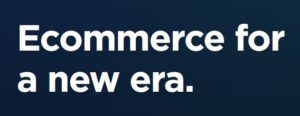In Dapp 30, we start with very simple smart contracts and Dapps, like Split payments or Wallets. Then we progressively increase the difficulty with Dapps like Multisig wallets, DAO, all the way up to advanced Dapps like decentralized Ebay, Twitter, and ERC20 ICO.
Â
Julien Klepatch – Dapp 30
Â
How to get your first Blockchain developer job?
1. You need to know how to build decentralized applications on the Blockchain (Dapps)
2. And you need to convince company that you know 1.
Most people think that you need to start from 1., and move your way to 2. But that’s not the most effective way…after all, what’s the point of studying all this Blockchain stuff if you can’t monetize it?
So… let’s reverse engineer the problem, and start from 2.
The good news is that there IS a simple method to convince Blockchain companies to hire you…
However, most Blockchain development course won’t teach you this…
The solution, my friend, is to…
Build a portfolio of Blockchain applications (Dapps)
There is nothing more effective that a portfolio of projects to demonstrate your technical skills.
No need to over-optimize your CV, or exaggerate your past achievements. This does not work. Just show your code.
Ok great, but… what should you build?
A good portfolio is like a good wardrobe: you have a little bit of everything to cover different use-cases.
For Ethereum Dapps that means:
Financial applications (Manipulate Ether, ERC20, ICO…)
Good knowledge of tokens (ERC20, ERC721)
Governance (DAO)
Game (ERC721, Crypto-collectibles)
Generate randomness
Importing data to the Blockchain (oracles)
Low-level knowledge of the EVM (assembly)
Your portfolio should also demonstrate that you know how to:
Write safe Solidity smart contracts => smart contracts manipulate money, safety is VERY important
Test your Solidity code => smart contracts can’t be updated, so tests are VERY important
Integrate smart contracts with your frontend by using Web3
Integrate frontend with wallets like Metamask
Have a modern reactive UI, by using frontend Dapp framework like Drizzle
Know how to use modern development tools of Ethereum
Phew! That’s a lot to take in… So… how are you going to come up with a Dapp portfolio that not only satisfies all the above conditions BUT also which starts simple and increase in difficulty, so that you have the time to learn progressively?
Dapp 30, a stunning collection of 30 decentralized applications
Dapp 30 is a course for Blockchain development where we build 30 decentralized applications (Dapps) on the Ethereum Blockchain.
This course will teach you:
How to develop advanced smart contracts with Solidity and Remix
How to tests your smart contracts like a pro with Truffle and Openzeppelin testing utilities
How build stunning & reactive frontend UI connected to your smart contracts, using Truffle, Web3, Metamask, React & Drizzle
I built Dapp 30 by using the portfolio of Dapps I used myself to learn Ethereum and get my first Blockchain job paid 100k USD / year (remote).
In Dapp 30, we start with very simple smart contracts and Dapps, like Split payments or Wallets. Then we progressively increase the difficulty with Dapps like Multisig wallets, DAO, all the way up to advanced Dapps like decentralized Ebay, Twitter, and ERC20 ICO.
You can find the full list of Dapps if you scroll down and click on the down arrow to expand the full curriculum.
It’s important to have a nice Dapp portfolio, but it’s also important to use the right tools and technologies. Otherwise, if you use outdated tech, it’s going to be difficult to be hired.
Get immediately download Julien Klepatch – Dapp 30
Dapp 30 covers all the modern technologies of Blockchain & Ethereum
Solidity, the most popular language of smart contracts
Remix, and easy to use IDE for Solidity
Truffle, the most popular framework for Solidity smart contracts
Openzeppelin, a secure library for Solidity
Web3, a library to integrate frontends with smart contracts
Drizzle, a library to keep your frontend up-to-date with smart contracts (reactive UI)
Javascript, React
For all these techs, we use the latest versions. Many course are outdated, but Dapp 30 regularly receives updates. For example, Dapp 30 uses Solidity 0.5 and web3 1.2, whereas many other courses use Solidity 0.4 and web3 0.x…
Are you a builder (#BUIDL)?
There are 2 kind of developers:
#1 The scholars
#2 The builders
Scholars like to study programming…but they don’t build much, and they generally don’t have the best jobs (or no job at all!!).
Builders prefer to build stuffs. They learn better by building, but they also love the process of building. And, last but the least, they get way better jobs.
This course is definitely for builders.
There is no long introduction with boring theoretical explanations. It starts straight with your first smart contract, and give you the explanations you need as we progress.
Because the course is progressive, you are never overwhelmed with too much difficulty. Knowledge is delivered just when it’s needed.
What are the pre-requisites?
This is not a beginner course. You need to have at least 1 year of experience as a web developer.
On the other hand, you don’t need to be a frontend expert to follow. You just need to understand the basics of web development (html, css and Javascript).
On the Blockchain side, no experience is required.
Details of what you will learn
For each Dapp, the tutorials will be broken down in:
Smart contract
Tests
Frontend
Smart contracts (Solidity)
Develop Solidity smart contract with the Remix IDE
Deploy and Interact with smart contracts in Remix IDE
Run a local development Blockchain in Remix IDE
Structure of smart contracts
Variables: string, integers, arrays, structs…
Functions: view, public, private
Calls vs Transactions
Storage vs Memory variables
Security considerations
Test smart contracts
Remix
Solidity
Tests
How to tests your Solidity smart contract with Truffle
How to do advanced tests like time-sensitive tests
How to use advanced testing libraries for Solidity development, like the oppezelllin test helper
How to test ERC20 and ERC721 tokens, and many more
Truffle
Solidity
Frontend
How to integrate a smart contract using Web3
How to integrate the frontend of a Dapp with Metamask
How to deploy to public testnet (ex: Ropsten) or Mainnet
Truffle
Web3
Infura
Javascript
React
Drizzle
When you buy this course you get access to
30 high-quality video tutorials for Ethereum decentralized applications from simple to advanced level
Covers smart contract development (Solidity, OpenZeppelin), smart contract tests and integration with frontend UI (Truffle, Web3, React)
Complete source code of all tutorials (git repo)
Access to a private Telegram with other students of Dapp 30
Lifetime support from the instructor, Julien
Bonus 1: mini-course on smart contract security
Bonus 2: mini-course on smart contract debugging
Bonus 3: lifetime access for course updates
Your Instructor
Julien Klepatch
Hi! My name is Julien and I am the instructor of EatTheBlocks Pro.
I am a senior Blockchain software engineer. I used to work in Finance, and I switched to software development 6 years ago.
For the past 3 years, I have been building Dapps and Solidity smart contracts for several Ethereum and ICOs projects, including Lendingblock, an institutional crypto lending exchange.
I run EatTheBlocks, a youtube channel for Ethereum developers. I have also published a Blockchain course for Manning.
I also contribute to the code of Drizzle and I spoke at TruffleCon 2019 on Drizzle.
I also have extensive experience with Nodejs, Javascript & React, having worked as a full-stack software engineer for the last 6 years. Github & LinkedIn
Get immediately download Julien Klepatch – Dapp 30
Course Curriculum
Introduction
What this course will teach you?
Who is this course for?
How to use this course? (IMPORTANT!)
Supported operating systems
Installation of required tools & libraries
Need help for the course? 24/7 support available here
Day 1 – Simple smart contract
Smart contract (13:45)
Tests (10:54)
Frontend (25:15)
Day 2 – Hello World
Smart contract (10:06)
Tests (5:03)
Frontend (11:30)
Day 3 – Simple storage
Smart contract – part I (11:58)
Smart contract – part II (5:54)
Tests (3:34)
Frontend (18:37)
Day 4 – Advanced storage
Smart contract (10:32)
Tests (12:16)
Frontend (39:36)
Day 5 – Crud
Smart contract – part I (9:11)
Smart contract – part II (4:52)
Smart contract – part III (4:36)
Smart contract – part IV (6:02)
Tests (15:51)
Frontend (59:45)
Day 6 – Ether Wallet
Smart contract – part I (4:18)
Smart contract – part II (5:54)
Smart contract – part III (6:46)
Tests (22:49)
Frontend
Day 7 – Split payment
Smart contract – part I (5:33)
Smart contract – part II (7:00)
Tests (15:21)
Frontend
Day 8: Deed
Smart contract (11:38)
Tests (11:39)
Frontend
Day 9: Deed multi-payouts
Smart contract – part I (4:29)
Smart contract – part II (4:10)
Smart contract – part III (6:15)
Smart contract – part IV (6:22)
Tests (11:45)
Frontend
Day 10: Escrow
Smart contract – part I (1:26)
Smart contract – part II (10:16)
Smart contract – part III (5:23)
Smart contract – part IV (5:15)
Tests (13:40)
Frontend (15:27)
Day 11: String manipulation
Smart contract (10:28)
Tests (2:57)
Frontend (13:02)
Day 12: Fibonacci
Smart contract (7:27)
Tests (2:08)
Frontend (0:40)
Day 13: Multisig wallet
Smart contract – part I (2:18)
Smart contract – part II (7:37)
Smart contract – part III (14:06)
Tests (12:39)
Frontend (21:33)
Day 14: Voting
Smart contract – part I (6:06)
Smart contract – part II (8:59)
Smart contract – part III (12:29)
Tests (16:19)
Frontend (32:03)
Day 15: DAO
Smart contract – part I (3:10)
Smart contract – part II (10:56)
Smart contract – part III (10:34)
Smart contract – part IV (14:50)
Smart contract – part V (16:52)
Tests (23:21)
Frontend (0:31)
Day 16: Loan state machine
Smart contract – part I (13:14)
Smart contract – part II (12:18)
Tests (0:35)
Frontend (0:49)
Day 17: Event organization
Smart contract – part I (14:46)
Smart contract – part II (9:07)
Tests (0:34)
Frontend (0:35)
Day 18: Lottery
Smart contract – part I (10:52)
Smart contract – part II (20:59)
Tests (1:26)
Frontend (1:21)
Day 19: Fomo3D
Smart contract – part I (15:07)
Smart contract – part II (16:08)
Tests (Unpublished)
Frontend (Unpublished)
Day 20: Rock paper scissors
Smart contract – part I (12:21)
Smart contract – part II (13:26)
Smart contract – part III (15:46)
Tests (0:36)
Frontend (2:11)
Day 21: ERC20 token
Smart contract (28:23)
Tests
Frontend (21:56)
Day 22: ICO
Smart contract (40:00)
Tests
Frontend (16:17)
Day 23: ERC721 token
Smart contract – part I (16:35)
Smart contract – part II (52:24)
Tests
Frontend (1:45)
Day 24: Crypto-kitties game
Smart contract (37:59)
Tests
Frontend (14:10)
Day 25: Twitter
Smart contract (42:02)
Tests
Frontend (Unpublished)
Day 26: Ebay
Smart contract (42:02)
Tests
Frontend (Unpublished)
Day 27: Tinder
Smart contract (44:52)
Tests (Unpublished)
Frontend (Unpublished)
Day 28: Arbitrage trading with Dex + Oracle Pattern
Smart contract (45:40)
Tests (Unpublished)
Frontend (Unpublished)
Day 29: Assembly
Smart contract – Beginner (25:44)
Smart contract – Advanced (12:35)
Day 30: Decentralized Exchange for ERC20 (Beta)
Introduction
Architecture of Decentralized Exchanges
Specifications of our Decentralized Exchange
Tech stack we will use
Smart contract – 1 – Token registry (4:01)
Smart contract – 2 – Wallet (6:57)
Smart contract – 3 – Integration with Dai (3:49)
Smart contract – 4 – ERC20 tokens Mocks (1:46)
Smart contract – 5 – Limit orders & orderbook (12:52)
Smart contract – 6 – Market orders & order matching algorithm (17:12)
Smart contract – 7 – Prevent integer overflow bug (8:13)
Smart contract – 8 – List orders
Smart contract – 9 – List tokens
Tests – 1 – Wallet
Tests – 2 – Limit orders
Tests – 3 – Market orders
Potential improvements & edge cases
Get immediately download Julien Klepatch – Dapp 30
Bonus 1: DeFi (Decentralized Finance) Programming
NOTE
Introduction to DeFi (12:07)
Building Blocks of DeFi (10:45)
Dai (28:28)
Uniswap (20:32)
Compound (29:02)
Gnosis (36:06)
Bonus 2: Smart contract security
1. Overflow / underflow – problem (7:23)
2. Overflow / underflow – solution (6:40)
3. Default function visibility – problem (3:35)
4. Default function visibility – solution (3:27)
5. Front-running – problem (5:52)
6. Front-running – solution (4:20)
7. Re-entrancy attack – problem (4:10)
8. Re-entrancy attack – solution (3:28)
Bonus 3: Smart contract debugging
1. Debugging Calls vs Transactions (1:42)
2. Syntax, runtime and logic errors (7:14)
3. Debugging with syntax highlighting (10:00)
4. Types of runtime errors (2:59)
5. Debugging out of gas errors (6:55)
6. Debugging revert and not-an-opcode errors (7:23)
7. Inspect storage with calls and returns (5:48)
8. Debugging with require revert (8:36)
9. Debugging with events (9:30)
10. Debugging with remix debugger (10:28)
11. Debugging with remix debugger advanced (7:55)
Bonus 4: Drizzle
Note
Introduction to Drizzle (48:07)
Advanced Drizzle (47:39)
Bonus 5: Find your first Blockchain Job
NOTE
Job boards for Blockchain jobs
Solidity Interview Preparation – Easy questions (15:50)
Solidity Interview Preparation – Intermediate questions (17:19)
Solidity Interview Preparation – Difficult questions (8:14)








